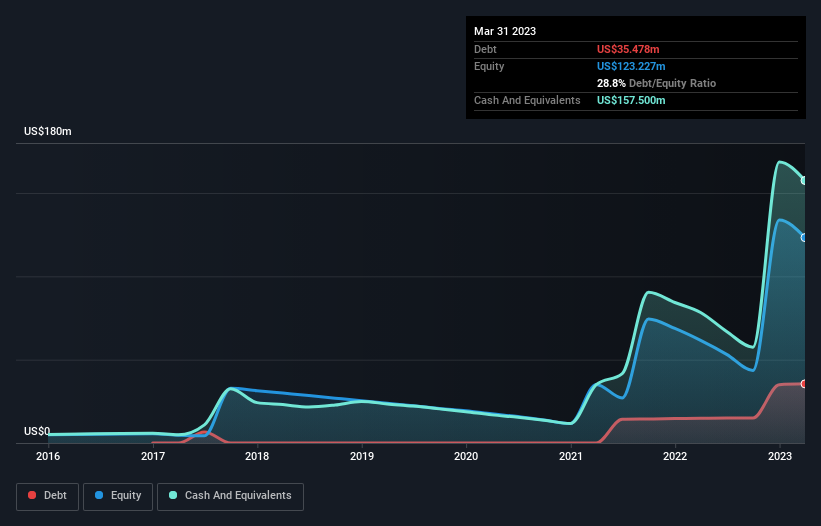The external fund manager backed by Berkshire Hathaway's Charlie Munger, Li Lu, makes no bones about it when he says 'The biggest investment risk is not the volatility of prices, but whether you will suffer a permanent loss of capital.' So it might be obvious that you need to consider debt, when you think about how risky any given stock is, because too much debt can sink a company. We can see that Celcuity Inc. (NASDAQ:CELC) does use debt in its business. But the real question is whether this debt is making the company risky.
Why Does Debt Bring Risk?
Debt is a tool to help businesses grow, but if a business is incapable of paying off its lenders, then it exists at their mercy. Ultimately, if the company can't fulfill its legal obligations to repay debt, shareholders could walk away with nothing. However, a more frequent (but still costly) occurrence is where a company must issue shares at bargain-basement prices, permanently diluting shareholders, just to shore up its balance sheet. By replacing dilution, though, debt can be an extremely good tool for businesses that need capital to invest in growth at high rates of return. When we examine debt levels, we first consider both cash and debt levels, together.
View our latest analysis for Celcuity
What Is Celcuity's Debt?
You can click the graphic below for the historical numbers, but it shows that as of March 2023 Celcuity had US$35.5m of debt, an increase on US$14.8m, over one year. But on the other hand it also has US$157.5m in cash, leading to a US$122.0m net cash position.

How Healthy Is Celcuity's Balance Sheet?
Zooming in on the latest balance sheet data, we can see that Celcuity had liabilities of US$5.81m due within 12 months and liabilities of US$35.8m due beyond that. Offsetting this, it had US$157.5m in cash and US$38.3k in receivables that were due within 12 months. So it actually has US$115.9m more liquid assets than total liabilities.
This surplus liquidity suggests that Celcuity's balance sheet could take a hit just as well as Homer Simpson's head can take a punch. On this view, lenders should feel as safe as the beloved of a black-belt karate master. Simply put, the fact that Celcuity has more cash than debt is arguably a good indication that it can manage its debt safely. When analysing debt levels, the balance sheet is the obvious place to start. But ultimately the future profitability of the business will decide if Celcuity can strengthen its balance sheet over time. So if you want to see what the professionals think, you might find this free report on analyst profit forecasts to be interesting.
Given its lack of meaningful operating revenue, Celcuity shareholders no doubt hope it can fund itself until it has a profitable product.
So How Risky Is Celcuity?
By their very nature companies that are losing money are more risky than those with a long history of profitability. And the fact is that over the last twelve months Celcuity lost money at the earnings before interest and tax (EBIT) line. And over the same period it saw negative free cash outflow of US$43m and booked a US$45m accounting loss. But at least it has US$122.0m on the balance sheet to spend on growth, near-term. Even though its balance sheet seems sufficiently liquid, debt always makes us a little nervous if a company doesn't produce free cash flow regularly. When analysing debt levels, the balance sheet is the obvious place to start. But ultimately, every company can contain risks that exist outside of the balance sheet. Case in point: We've spotted 3 warning signs for Celcuity you should be aware of, and 1 of them is significant.
If you're interested in investing in businesses that can grow profits without the burden of debt, then check out this free list of growing businesses that have net cash on the balance sheet.
New: AI Stock Screener & Alerts
Our new AI Stock Screener scans the market every day to uncover opportunities.
• Dividend Powerhouses (3%+ Yield)
• Undervalued Small Caps with Insider Buying
• High growth Tech and AI Companies
Or build your own from over 50 metrics.
Have feedback on this article? Concerned about the content? Get in touch with us directly. Alternatively, email editorial-team (at) simplywallst.com.
This article by Simply Wall St is general in nature. We provide commentary based on historical data and analyst forecasts only using an unbiased methodology and our articles are not intended to be financial advice. It does not constitute a recommendation to buy or sell any stock, and does not take account of your objectives, or your financial situation. We aim to bring you long-term focused analysis driven by fundamental data. Note that our analysis may not factor in the latest price-sensitive company announcements or qualitative material. Simply Wall St has no position in any stocks mentioned.
About NasdaqCM:CELC
Celcuity
A clinical-stage biotechnology company, focuses on the development of targeted therapies for the treatment of various solid tumors in the United States.
High growth potential with adequate balance sheet.
Market Insights
Weekly Picks


Ferrari's Intrinsic and Historical Valuation


Investment Thesis: Costco Wholesale (COST)

Undervalued Key Player in Magnets/Rare Earth
Recently Updated Narratives


Is Global Payments (NYSE:GPN) The Undervalued Cash Cow Your Portfolio Needs?


Broadcom - A Fundamental and Historical Valuation


Hims & Hers Health aims for three dimensional revenue expansion
Popular Narratives


The "Sleeping Giant" Stumbles, Then Wakes Up


NVDA: Expanding AI Demand Will Drive Major Data Center Investments Through 2026






